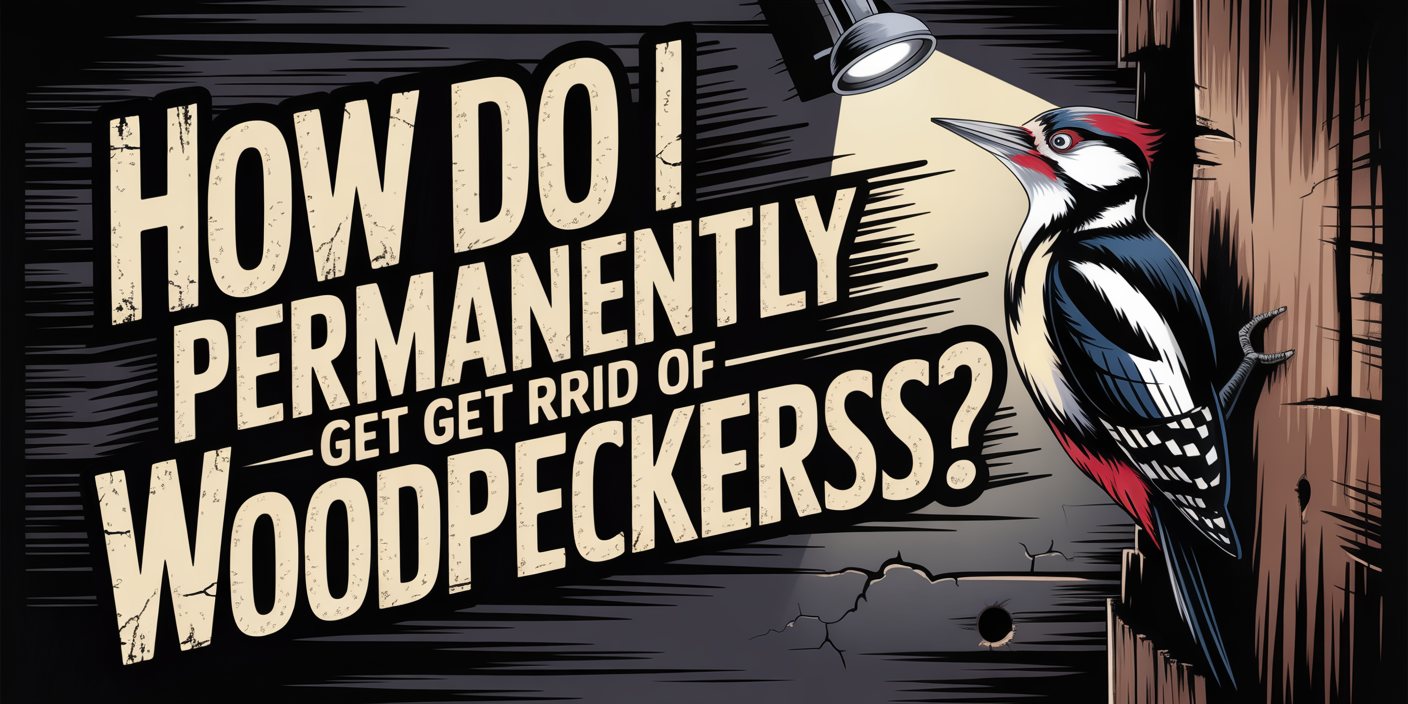“The only permanent way to get rid of woodpeckers is to remove what’s attracting them and block their access with humane exclusion methods. DIY tricks may work short-term, but long-term relief comes from professional wildlife control that targets both the bird and the reason it’s there.”
Woodpeckers might seem charming in the wild, but when they start hammering away at your home in the Treasure Coast, it’s a whole different story. From early morning drilling on your siding to mysterious holes around your fascia, these birds can turn peaceful properties into echo chambers of frustration. Many homeowners don’t realize that woodpeckers are federally protected, which means getting rid of them isn’t as simple as scaring them off or setting traps.
If you’re dealing with relentless pecking, visible damage, or birds returning to the same spot year after year, it’s time to look beyond quick fixes. AAAC Wildlife Removal of Treasure Coast specializes in long-term, humane solutions designed to protect both your home and Florida’s native wildlife. In this guide, we’ll walk through exactly why woodpeckers show up, what damage they cause, and most importantly, how to get rid of woodpecker permanently without breaking the law—or your sanity.
Learn more: Who can I call to get rid of woodpeckers?
Why Are Woodpeckers Pecking at My House?
They’re Searching for Food
Woodpeckers are insect hunters at heart. If your home has bugs hiding behind the wood or stucco—especially ants, termites, or carpenter bees—they’ll start drilling into the surface to get a meal. Even small infestations can attract them fast.
They’re Marking Their Territory
The loud, repetitive tapping you hear might not be about food at all. This behavior, called “drumming,” is how woodpeckers communicate with potential mates and warn off rivals. Houses with hollow or resonant surfaces (like gutters or trim) make perfect amplifiers for these calls.
They’re Trying to Build a Nest
When the season’s right, woodpeckers start scouting out nesting spots. If your eaves, siding, or chimney has soft wood or existing holes, they might decide your house is the ideal location to raise their young. Once they nest, they’re hard to remove legally without expert help.
Treasure Coast Homes Are Prime Targets
With our warm weather, leafy neighborhoods, and year-round insect activity, homes in Port St. Lucie, Vero Beach, and Fort Pierce give woodpeckers everything they’re looking for. That’s why they’re a recurring nuisance for many Florida homeowners—not just a seasonal problem.
What Damage Can Woodpeckers Cause?
Woodpecker damage goes beyond surface-level holes and noise. Their constant pecking can drill deep into wood siding, fascia boards, trim, and even stucco, making your home vulnerable to moisture and decay. If left untreated, these holes can weaken the structure and result in costly repairs that could have been avoided.
In addition to structural concerns, these openings invite pests and moisture inside. Rainwater can seep through, causing mold to form within the walls, while insects or other wildlife—like bees and squirrels—can enter through the gaps. Even if you’re trying to keep woodpeckers away without harming them, ignoring early signs only increases the risk of long-term issues. And if you’ve been offering suet or other bird feed nearby, you might unintentionally be encouraging birds that end up damaging your home without harming them directly.
What Are the Best DIY Ways to Deter Woodpeckers?
- Visual Deterrents- Hanging reflective objects like shiny tape, aluminum pie pans, or old CDs can spook woodpeckers by mimicking predator movement and light flashes. Pinwheels, scare balloons with eyes, or even fake owls can also work—at least for a while. The key is to move them around frequently so the birds don’t get used to them.
- Sound-Based Disruption- Noise deterrents such as wind chimes, motion-activated alarms, or even banging pots can help discourage woodpeckers from returning. They dislike sudden or unpredictable sounds, especially if paired with movement or flashing lights. Just remember: these methods often lose effectiveness once the birds realize there’s no real threat.
- Tactile Barriers- Some homeowners apply bird-safe netting, mesh, or tactile strips over affected areas to block access. If the birds can’t land and peck, they’ll move on—but installation needs to be precise, especially around high or awkward spots. For large homes, this is usually where professional help becomes essential.
Are There Any Legal Restrictions for Removing Woodpeckers in Florida?
Yes—and they’re serious. All woodpecker species found in Florida are protected under the Migratory Bird Treaty Act, a federal law that makes it illegal to harm, capture, or remove these birds without a special permit. Even interfering with a nest that contains eggs or chicks can result in hefty fines or legal trouble, regardless of the damage they’re causing to your property.
That’s why removing woodpeckers is not a DIY job. You need a licensed wildlife expert who understands both the behavior of these birds and the legal steps required for safe, humane removal. AAAC Wildlife Removal of Treasure Coast uses compliant, ethical methods that keep both your home and native bird species protected—no shortcuts, no risk.
How Do You Permanently Get Rid of Woodpeckers?
Remove the Root Cause
Woodpeckers are persistent, but they’re not random. If your home has insect infestations or soft, hollow-sounding wood, it becomes an ideal target. Removing the food source—like ants or carpenter bees—is the first essential step toward long-term relief.
Reinforce and Repair Vulnerable Areas
Once the attractants are gone, it’s time to block their access. That means sealing any existing holes, replacing damaged wood, and reinforcing common targets like fascia boards or cedar siding with materials that are harder to peck. Without a place to drum or nest, woodpeckers usually move on.
Install Exclusion Devices
Bird netting, mesh, or flashing can be installed in problem spots to physically prevent woodpeckers from returning. These deterrents work best when placed precisely and paired with noise or visual cues. For larger homes or repeated issues, this is where expert installation really shines.
Call in a Professional for Long-Term Success
Permanently solving the problem often means going beyond deterrents. AAAC Wildlife Removal of Treasure Coast provides thorough inspections, identifies nesting or feeding triggers, and applies legal, humane strategies that actually work—no guesswork or band-aid solutions.
When Should You Call a Wildlife Removal Expert?
If a woodpecker keeps returning to the same spot on your home despite your best DIY efforts, it’s more than a random visit—it sees your house as part of its territory. Persistent pecking, especially in the early morning, is often a sign that the bird has either found food or is using your home to mark its presence. That kind of behavior rarely stops on its own.
Visible damage is another major red flag. Holes in your siding, chipped trim, or chirping noises inside your walls could indicate an active nest, which comes with legal complications. Because woodpeckers are federally protected, it’s illegal to disturb nesting birds without proper permits. That’s why it’s smart to contact a licensed expert like AAAC Wildlife Removal of Treasure Coast. Their team understands the laws, the species, and the safest, most humane way to solve the problem permanently.
What Does AAAC Wildlife Removal of Treasure Coast Do Differently?
AAAC Wildlife Removal of Treasure Coast takes a complete, legal, and humane approach to solving woodpecker problems—something you won’t get with store-bought gadgets or guesswork. It starts with a detailed inspection of your home to identify what’s attracting the birds in the first place, such as insect activity, soft wood, or previous nesting spots. From there, the team creates a custom plan that addresses both the damage and the behavior behind it.
Rather than just scare the birds away, they install physical deterrents, repair entry points, and apply exclusion techniques designed to keep woodpeckers out for good. Their knowledge of Florida’s bird species, nesting patterns, and legal regulations ensures every job is handled ethically and effectively. It’s not just about removing a nuisance—it’s about protecting your home long-term without violating federal wildlife laws.
Ready to Protect Your Home from Woodpeckers for Good?
Don’t let a small peck turn into major damage. If you’re dealing with woodpecker activity anywhere around your home—siding, roofline, chimney, or fascia—it’s time to call in the pros before things get worse. AAAC Wildlife Removal of Treasure Coast has the tools, training, and local expertise to solve the problem safely and permanently.
Serving homeowners across Port St. Lucie, Fort Pierce, Vero Beach, and surrounding areas, our team provides fast inspections, humane solutions, and lasting prevention. Give us a call today and let’s stop the pecking before it spirals into costly repairs. Your home deserves peace and quiet—and we’re here to help make that happen.




